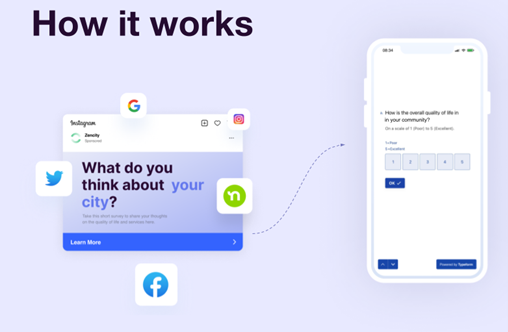Overview
The City of Tampa is partnering with Zencity, a community input and insights platform local governments use to get meaningful feedback from more residents and better understand community concerns and priorities.
In under five minutes, residents can help local government leaders know how they feel on a wide range of topics around life in our community—from what they think is working, to where they see a need for improvement—providing valuable feedback that is used to calculate ongoing satisfaction scores. The survey is available in English and Spanish to make it accessible for as many residents as possible.
City of Tampa employees will receive periodic reports from Zencity with survey results and analysis. Once the necessary sampling of responses has been received, the City of Tampa will share the results with the public.
Where can I take the survey?
The survey will appear to residents using digital ads in various locations such as social media platforms. Zencity uses dynamic online sampling to ensure surveys reach the full spectrum of residents for a diverse representative sample reporting the entire community. The ads will appear like this on mobile devices and can be completed on personal computers as well:

In addition, residents can find and respond to the survey here:
Zencity Survey

What questions will be asked?
The survey tool will measure resident satisfaction regarding local services and quality of life in the community, while also identifying key concerns residents want the local government to address. Topics include affordable housing, health care, economy and jobs, transportation, public safety, and education.
How do you verify respondents are local residents?
Zencity uses existing digital advertising networks to target digital advertisements, localized to reach each community. Those who see the ad and choose to take the surveys voluntarily provide their ZIP code. The combination of where the ads are targeted combined with the respondent’s self-reported ZIP code enables the assignment of a response to a community.
Is it anonymous?
Zencity takes protecting privacy and ensuring respondent anonymity seriously. All survey responses are completely confidential, and they do not collect any personal information that could identify a specific respondent (except, where applicable, an email address, for those that opt-in to participate in similar surveys in the future). Zencity only collects the survey question responses that are provided, along with anonymous metadata, which are used to improve the quality of the advertisements. There is no way that Zencity can identify an individual from the survey responses provided. For respondents who opt-in to future research, email addresses are not used to link the address to specific survey responses.
Further, Zencity does not share individual-level responses to the surveys with customers, only aggregated numbers, summaries, or disaggregated and anonymized open-ended responses. Zencity removes any information that could potentially be used to de-anonymize comments provided. Finally, all survey responses are stored in secure, encrypted databases, using industry best practices.
Zencity’s policies and practices are in accordance with the leading data privacy regulations such as, where applicable, the California Consumer Privacy Act (CCPA) and EU's General Data Protection Regulation (GDPR). The full privacy policy can be found at zencity.io/privacy-policy.
Is the survey representative?
Zencity collects a representative sample of opinions from the population in any geographic area surveyed while minimizing potential sources of statistical bias. Zencity uses proprietary technology to track the demographic representativeness of its samples in real-time and make corresponding adjustments to ad targeting to maximize representativeness. In communities where many residents are not native English speakers, questionnaires are available in multiple languages and reach out to potential respondents in their native languages.
Zencity uses the annually updated U.S. Census American Community Survey data to set response targets for each geographic area based on five different variables: race, age, sex, education level, and household income. Based on self-reported demographic data collected in the survey, they track the demographic representativeness of the respondents in real-time and make adjustments to obtain a closely representative sample.
Can the public see the results?
Once the necessary sampling of responses has been received, the City of Tampa will share the results with the public.
